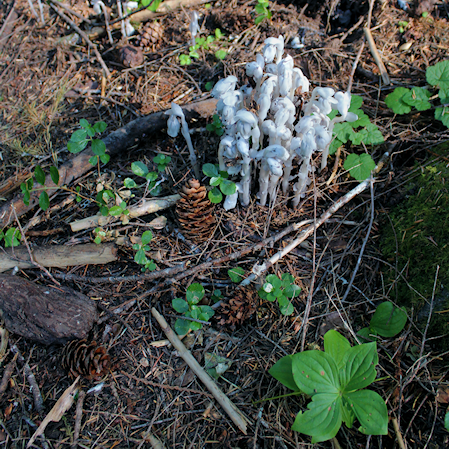Indian Pipe is a Parasitic Plant of Trees and Fungus
On a recent hike along Pamilia Creek, I came across this clump of Indian Pipe growing under a dense stand of large Douglas fir. It caught my eye, because even though it’s a herbaceous plant, it looks more like a fungus.
In fact, I always assumed Indian Pipe, like many fungi, lived off of the decomposing leaf litter of the forest floor. After all, it doesn’t have chlorophyll and can’t manufacture its own food. But I was wrong. Again.
Today scientists know that there aren’t any plants capable of directly breaking down of organic matter. None.
If Indian Pipe can’t make its own food because it doesn’t have chlorophyll, and it can’t use the decomposing leaf litter, how’s it survive?
It’s a Parasite
In order to get food, the roots of Indian Pipe specializes in a form of parasitism known to scientists as myco-heterotrophy.
And here’s how it works. Indian Pipe takes nutrients from the roots of a tree, but not directly. It actually has its roots tap into and take nutrients from a fungus associated with the tree’s roots.
But in order for that to make any sense, you have to understand the relationship between the fungus and the tree.
You see, the fungus and tree have a mutually beneficial thing going on. The fungus is all these tiny, thin threads like microscopic roots, which are known as mycellia. The mycellia are much smaller than even the finest roots of the tree. And they tap directly into the tree’s roots. Which the tree is very cool with, because the mycellia are like extension cords for the roots. They get into a way larger volume of soil that the tree ever could on its own.
The mycellia pass some of the water and mineral nutrients they absorbed from the soil to the tree. In exchange, the fungus gets carbohydrates from the tree. Each organism helps the other out in this symbiotic relationship.
Many fungi and trees have this type of relationship — called a mycorrhizal relationship.
Back to the Indian Pipe
Indian Pipe is a freeloader. It doesn’t give anything back to the fungus or the tree. It takes mineral nutrients from the fungus that the fungus had gotten for itself, and it also takes carbohydrates that the fungus gets from the tree. It’s a direct parasite of the fungus and an indirect parasite of the tree. That’s the fairly unusual form of parasitism known as myco-heterotrophy.
I am always amazed at what I can learn from a simple walk through the woods. Like how many of the links between plants, the soil, and water are hidden from my casual observation. Truth be told, I didn’t know that Indian Pipe was a parasite until I looked into it for this post. I wonder what else I think is so, but isn’t.
The scientific name for Indian Pipe is Monotropa uniflora. It’s also known as the Ghost Plant or Corpse Plant

